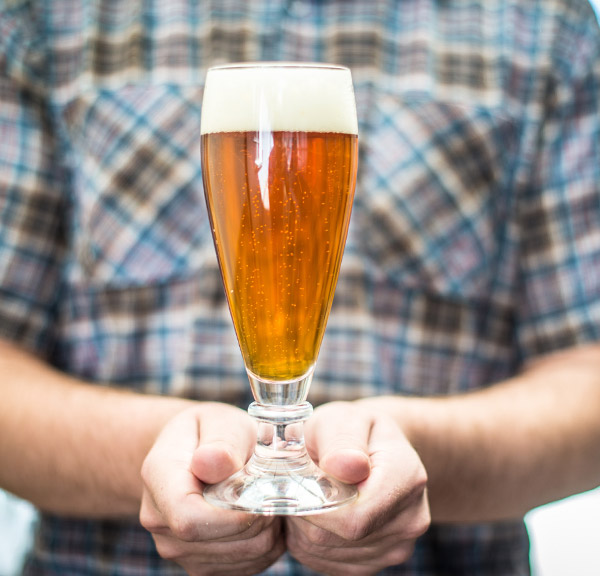
by Duncan Bryant, AHA Web Coordinator
I first heard of Grätzer (also commonly known as Grodziskie) when it was added to the Great American Beer Festival® competition style guidelines in 2013. I have recently found a few pro-examples locally—Grimm Brothers Brewhouse Sooty Brother and a New Belgium/Three Floyds collaboration—and it got me thinking about the centuries-old style that was almost lost in obscurity.
History
In the 15th century, Grätzer appeared in the Polish city of Grodzisk, at a time when the Prussian Empire was spreading across central Europe. Fast forward to the 19th century, and Grodzisk was under the Prussian Empire and more commonly referred to under its German name, Grätz. The beer style grew in popularity within the Prussian Empire, particularly in modern day Poland and Northern Germany, where it took on the alternative name Grätzer, meaning the beer from Grätz.
The last commercial Grätzer brewery closed in the 1930s, and with it came the near extinction of the Polish style. Luckily, home and commercial brewers are beginning to explore Grätzer and other ancient styles, breathing new life into styles that were nearly forgotten.
Ingredients & Profile
At its oldest and most basic point, Grätzer was simply an oak-smoked wheat beer, with a dose of noble hops and top fermenting yeast, typically weighing in at 2-6 percent ABV. Raw wheat was traditionally kilned over a oak-fed fire, creating the signature smoke aroma and flavor. The result: a deliciously golden brew, with oaky wheatiness, some apple-fruit character in the nose and a subtle noble hop bitterness , all brought to life by a high level of champagne-like carbonation from bottle conditioning.
Some brewers prefer more hop bitterness, or a small percentage (5-7 percent) of darker kilned wheat malt to create a more amber color.
While homebrewers can give smoking their own wheat a shot, Weyermann makes an oak-smoked pale wheat malt meant specifically for styles like Grätzer.
The Nowotomyski hops, a hybrid Bavarian/Bohemian-Czech variety used in Grätzer since the mid-19th century, are nearly impossible to find these days. Polish Lubliner are a good substitute, but Saaz, Tettnanger or Hallertauer Mittelfruh might be easier to find.
The signature water from Grodzisk’s main wells—the stuff of legends—tends to have high levels of calcium, sulfate and calcium carbonate with moderate levels of magnesium, sodium and chlorine. For a more precise water report, see “Project Grodziskie: A Polish Renaissance” in the November/December 2012 Zymurgy.
It is said two different yeasts were used to ferment Grätzer, one highly flocculent and the other a bit powdery. For the homebrewer, it would be ideal to find a neutral Polish ale yeast. If unavailable, any neutral ale yeast will do just fine, but avoid wheat beer yeasts that contribute prominent flavors and aromas.
Traditional Grätzer
- Ingredients for 5 gallons:
- 8.0 lb | Weizenrauchmalz*
- 1.5 oz | Lublin hops, 3.7% aa (60 min)
- 0.5 oz | Lublin hops, 3.7% aa (30 min)
- Neutral Ale yeast
- Specifications:
- Original Gravity: 1.041
- Strength: 4% ABV
- Bitterness: 20 IBU
- Color: 2 SRM
- Directions:
- Conduct the following mash schedule*: 30 minutes at 100°F; 30 minutes at 125°F; 30 minutes at 158°F; and mashout. Conduct a 90-120 minute boil, following the hop schedule as noted above. Once ready, carbonate to 3.0-3.5 volumes of CO2
- *You can substitute a single infusion mash at 148-150°F for 60 minutes instead of the stepped schedule.
Brewing Process
Brewing Grätzer traditionally consists of three or four mash rests using boiling water infusions to reach each step. Mash schedules vary, but based on the last Polish commercial Grätzer, the schedule is as follows: 100°F for 30 minutes; 10-minute infusion and hold at 125°F for 30-60 minutes; 20-minute infusion and hold at 158°F for 30 minutes; and one last infusion to mash out around 167°F.
Boil time can be as long as 2-2.5 hours, with average 1.031 Original Gravity being the target. According to the same records reference for the above mash schedule, two whole hop additions are added at 45 minutes and 30 minutes from the end of the boil, with 80 percent of the target ~22 IBUs in the first addition.
Fermentation temperatures can be held on the lower side of the yeast strain’s tolerance threshold to minimize characteristics from the yeast.
After fermentation, bottle prime to reach near-champagne levels of carbonation (3.0-3.5 volumes CO2). All that’s left is to pop the cap, pour it into a glass that can accommodate the aggressive head and enjoy the deliciously smoky and sessionable wheat beer.
A history lesson has never tasted so good!
Sources: Radical Brewing by Randy Mosher; Tasting Beer by Randy Mosher; “Project Grodziskie: A Polish Renaissance” by William Shawn Scott (Nov/Dec 2012 Zymurgy); Great American Beer Festival Style Guidelines.

Share Post